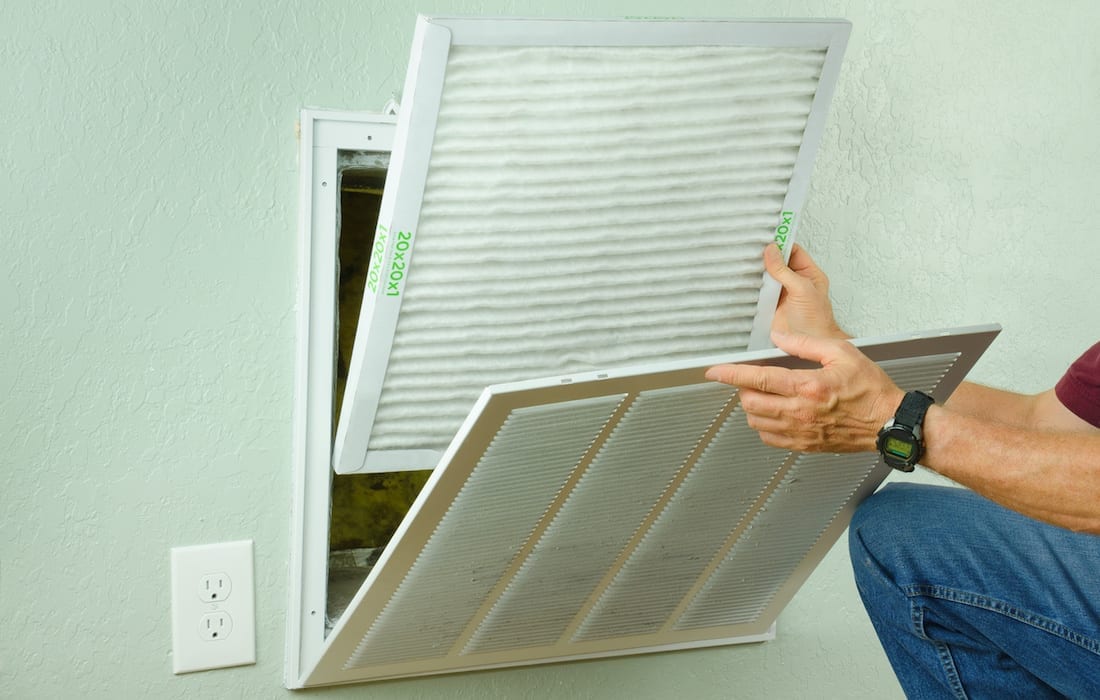Your home has a small yet vital component that plays a crucial role in maintaining indoor air quality and HVAC system efficiency—the air filter. Homeowners often underestimate the significance of this simple component, not realizing that it can have a profound impact on both their well-being and the longevity of their HVAC system.
In this guide, we will delve into air filters, their importance, the different types available, when they should be replaced, and the essential steps homeowners need to follow to replace them.
What Do Air Filters Do for You & Your HVAC System?
Air filters are fundamental components of HVAC systems, designed to capture airborne particles like dust, pollen, pet dander, and even mold spores. Their primary role is to improve indoor air quality and protect the HVAC system itself.
Improving Indoor Air Quality
Air filters act as barriers, trapping particulate matter and preventing it from circulating throughout your home. This means cleaner air for you and your family, reducing the risk of allergies, respiratory issues, and other health concerns.
Protecting Your HVAC System
Airborne particles can wreak havoc on your HVAC system. When they enter the system, they can clog components like the evaporator coil, fan, and blower motor. This not only reduces efficiency but can also lead to costly repairs or premature system failure.
Types of Air Filters for HVAC Systems:
Before we dive into when and how to change your air filter, let’s explore the different types of filters available:
- Fiberglass Filters: These are the most basic and affordable filters. They are typically blue or white and are designed to capture larger particles. While they provide some filtration, they may not be effective against smaller allergens or pollutants.
- Pleated Filters: Pleated filters have a greater surface area than fiberglass filters, making them more efficient at trapping particles. They are available in various MERV (Minimum Efficiency Reporting Value) ratings, indicating their filtration efficiency.
- Electrostatic Filters: Electrostatic filters use static electricity to attract and trap particles. They are effective against smaller contaminants and can be washable and reusable, reducing long-term costs.
- HEPA Filters: High-Efficiency Particulate Air (HEPA) filters are known for their exceptional filtration capabilities. They can capture particles as small as 0.3 microns, making them ideal for those with allergies or asthma.
How Often Should You Change Your Furnace or Air Conditioner Air Filter?
Now that we understand the types of air filters, let’s discuss how often you should change them.
Your HVAC system is comprised of both your furnace and your air conditioning units put together, and all three share the same air filter. So there is only one air filter that needs to be changed.
The frequency of filter replacement depends on several factors:
- Filter Type:
-
- Fiberglass Filters: Every 30 days.
- Pleated Filters (MERV eight to 13): Every 60 to 90 days.
- Electrostatic Filters: Check the manufacturer’s instructions; some are washable and reusable.
- HEPA Filters: Every six to 12 months.
- Usage and Allergies: Homes with pets or allergy-prone residents may require more frequent filter changes, possibly every 20 to 45 days, as pets and allergens increase the load on filters.
- System Usage: A system that operates year-round will require more frequent filter changes compared to a seasonal system.
- Location: Homes located in areas with high levels of airborne pollutants may need more frequent filter changes.
- Manufacturer’s Recommendations: Always consult the manufacturer’s guidelines for your specific HVAC system and filter type.
Situations That May Require More Frequent Filter Changes:
Certain situations may necessitate changing your HVAC air filter more often than usual:
- Construction or Renovation: Dust and debris from construction projects can clog filters quickly. Change them before and after the project to maintain indoor air quality.
- Smoke or Wildfires: During periods of heavy smoke or wildfires, consider more frequent filter changes to minimize the intrusion of outdoor air pollutants.
- Illness or Allergies: If someone in your household is sick or experiencing allergies, replacing the filter can help reduce indoor air contaminants.
How to Replace Your Air Filter
Now, let’s get to the practical part: how to change your HVAC, furnace, and air conditioning system’s air filter. Follow these steps for a seamless filter replacement process:
- Turn Off Your HVAC System:
Ensure your HVAC system is turned off before attempting to replace the air filter. This prevents the fan from pulling in contaminants while you work. - Locate the Filter:
Find the filter’s location, which is typically near the return air duct in the furnace or air handler. The filter may be behind a removable panel or grille. Directions to remove the panel or grille are usually printed on the panel. Air filters look like a large, lightweight rectangle with cardboard edging and a mesh-type center for the filter. - Remove the Old Filter:
Carefully slide out the old filter. Pay attention to the direction of airflow indicated by arrows on the filter frame. - Note the Filter Size:
Before discarding the old filter, take note of its size, which is usually printed on the frame. This information is crucial when purchasing a replacement filter. - Purchase a New Filter:
Visit your local hardware store or order a replacement filter online. Make sure it matches your old filter’s size. - Install the New Filter:
Slide the new filter into place, ensuring it matches the direction of airflow indicated on the filter frame. The arrows should point toward the blower motor or furnace. There are often arrow markings on the HVAC system showing which direct the air blows. - Secure the Panel or Grille:
If a panel or grille was covering the filter, reattach it securely. - Turn On the HVAC System:
Finally, turn your HVAC system back on, and you’re all set with a fresh, clean filter.
Replacing your HVAC system’s air filter is a simple yet essential maintenance task that every homeowner should perform regularly. By doing so, you’ll ensure cleaner indoor air, improve system efficiency, and extend the lifespan of your HVAC equipment.
Remember to choose the right filter type, replace it at the recommended intervals, and keep an eye out for special circumstances that may require more frequent changes. Consider keeping some backup filters on hand in case you need to change it out early.
With these steps, you’ll be well on your way to a healthier home and a more efficient HVAC system. Make filter replacement a habit, and enjoy the benefits of cleaner, fresher air year-round.
If you need help figuring out how to replace your furnace filter, call your trusted local HVAC company. Fayette Heating & Air offers expert air conditioning and furnace maintenance services in Elsmere and Lexington, Kentucky.
Contact us today to schedule an appointment, and our HVAC technicians will tune up your AC or furnace and show you how to change out your HVAC air filter.


 Skip to content
Skip to content

